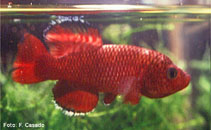| Family: |
Nothobranchiidae (African rivulines) |
| Max. size: |
10 cm TL (male/unsexed) |
| Environment: |
benthopelagic; freshwater; pH range: 6.5 - 7.5; dH range: 15, non-migratory |
| Distribution: |
Africa: coastal plain from the lower Zambezi region south to the Mkuze River, in Malawi, Mozambique, Zimbabwe and South Africa (Ref. 3788, 52193). Populations are threatened by destruction of pans and by anti-malarial and tsetse fly spraying programs (Ref. 7248). |
| Diagnosis: |
Dorsal spines (total): 0-0; Dorsal soft rays (total): 15-16; Anal spines: 0-0; Anal soft rays: 14-17. Description: Body robust (Ref. 52193). Head large, covered with scales; mouth dorsal, lower jaw projecting beyond upper jaw (Ref. 52193). Dorsal fin with 15-16 rays; anal fin with 14-17 rays; dorsal fin far bac, opposite the anal fin and generally equal in size; caudal fin large and rounded or semi-truncate (Ref. 52193). Scales in lateral series 27-32 (Ref. 52193). Colouration: Females plain fleshy brown with slight silvery or bluish inflections on scales and cheeks; fins clear (Ref. 52193). Red and blue colour forms are recognised in males, but are probably different expressions of a variable colour pattern; red spots on the head are diagnostic for the species; the red form has scales with yellow or blue centres and bright red edges, red caudal, pectoral and pelvic fins and red streaks to basal portion of dorsal and anal fins; distal half of dorsal and anal fins green with maroon spots, fin edge brilliant white; in the blue form the red colour is far less accentuated and blue-centred scales are predominant, fins clear green with small red bars and spots, caudal fin practically clear (Ref. 52193). |
| Biology: |
Found on temporary pools, floodplains, swamps, rice fields, ditches and small streams (Ref. 3788). A slow-moving fish usually found in sections of a river where aquatic vegetation provide some cover (probably as a means of avoiding predators). Feeds on mosquito larvae, small crustaceans and other aquatic organisms (Ref. 6465). Used for mosquito larva control. Collection for the aquarium trade is controlled (Ref. 7248). Bottom spawner, 3-5 months incubation; it is difficult to maintain in aquarium (Ref. 27139). |
| IUCN Red List Status: |
Least Concern (LC); Date assessed: 08 January 2019 Ref. (130435)
|
| Threat to humans: |
harmless |
Source and more info: www.fishbase.org. For personal, classroom, and other internal use only. Not for publication.

